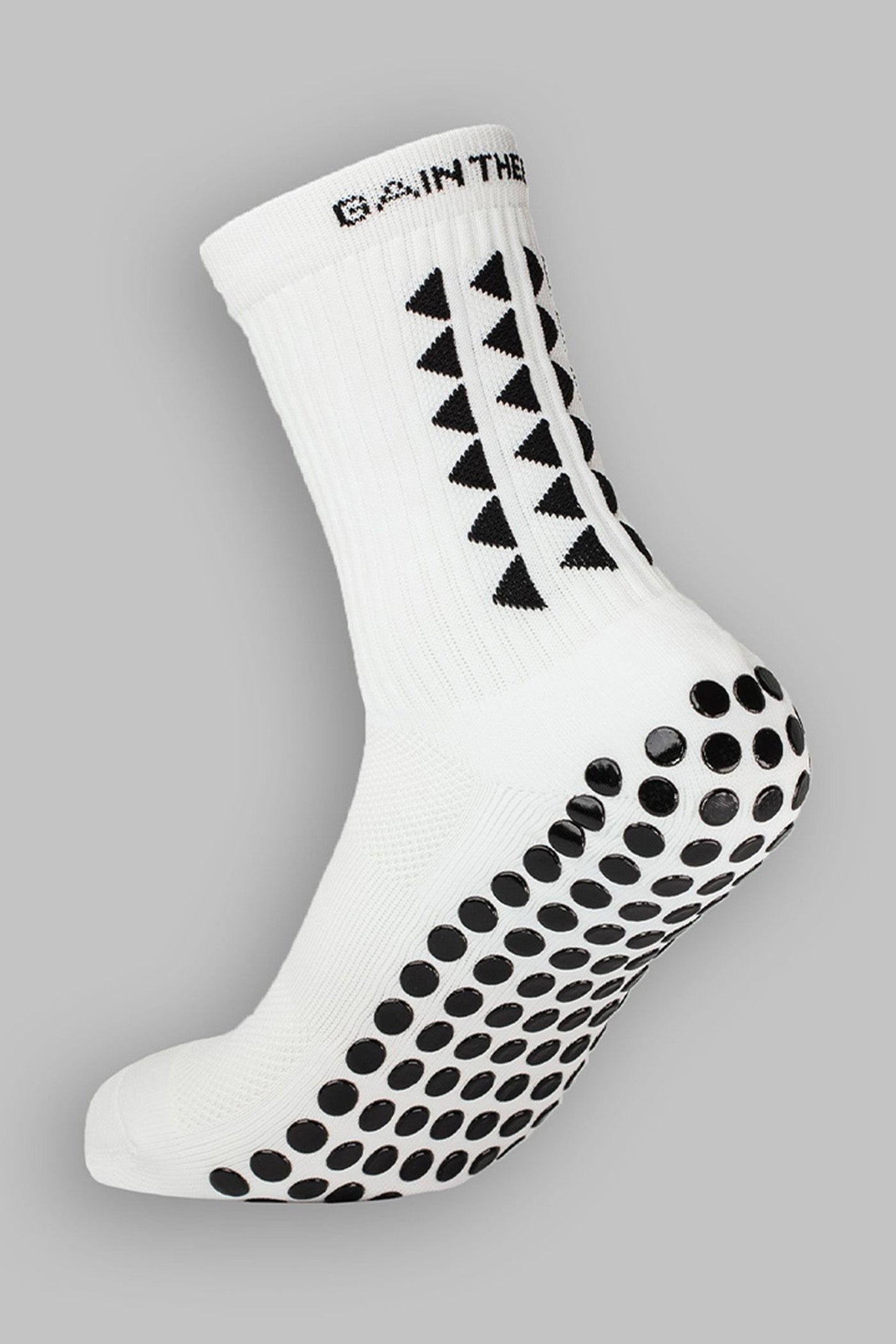Compression socks are used to treat everything from swollen travel ankles to big wounds after surgery or accidents. But if you’ve ever wondered, “Why do my compression socks hurt?”, it might be that you don’t have the right compression sock strength.
Before you choose a compression sock, it’s important to consider your pains and what you want to achieve with the compression socks.
Luckily, we’re here to guide you through the process with this complete guide on how tight should compression socks be. After this, you’ll be able to choose compression socks that fit your needs and bring the most benefit.
What this article covers:
- Factors to Consider when Deciding on Compression Sock Tightness
- How Tight Are Compression Socks Supposed to Be?
- What Happens if Compression Socks Are too Tight?
- How to Tell if Compression Socks Are too Tight
Factors to Consider when Deciding on Compression Sock Tightness
Compression socks have been around for years and have been studied extensively, proving their efficacy time and time again. So, when we say compression socks have great value, we mean it.
But before you determine what compression sock strengths are the best for you, it’s important to consider what your goals are with the compression socks you buy.
Do you need pain relief? Are you hoping to prevent or lessen spider veins during your pregnancy? Are you returning from surgery and looking for muscle, wound, and blood support?
Once you know what you are trying to achieve with the compression socks, you’ll have a better idea of where to go.
The more severe your swelling, pain, or injury, the higher the pressure or mmHg of the sock should be. If you need an everyday compression sock, 8 to 20 mmHg compression socks will be the best. They don’t exert too much pressure and can feel like normal socks.
If you’re struggling with severe pain or injuries, 20 to 40 mmHg will be better. The pressure of these socks will take some getting used to.
Finally, the firmest socks are 40 to 50 mmHg compression socks. We recommend consulting a doctor about heavy-duty compression socks because the pressure of these can be dangerous if worn too long.
How Tight Are Compression Socks Supposed to Be?
Compression socks, as the name suggests, are supposed to feel tight. Putting compression socks on should exert firm pressure all over the foot, ankle, and lower leg.
For many people, the pressure of the sock feels like a steady inward “push” or “hold” that supports the foot when standing and moving around. You should have mobility but some stiffness is okay.
For example, if you’re an athlete wearing compression grip socks, you should be able to move around freely but with a steady and firm mold around the leg.
That doesn’t mean compression socks are supposed to be unbearably tight. Unless you’re using prescription compression socks, most compression socks are safe enough to wear at night.
The design also plays a part in how the compression sock feels.
A good compression sock should apply most of the pressure on the ankle. The rest of the sock should have a lighter pressure, and there should be no point where the sock sharply cuts into the skin or cuts off blood circulation. That defeats the whole purpose of the sock.
If you’re not sure about the pressure of your compression sock, browse the best compression socks in the UK or consult your doctor to find a pair that suits your needs.
What Happens if Compression Socks Are too Tight?
Compression socks can be very tight and for many people, it’s extremely uncomfortable. But unless you’re wearing prescription-grade compression socks, they shouldn’t be causing serious discomfort.
Besides comfort, there’s a very real danger to wearing the wrong size or pressure compression socks.
A compression sock that is too tight can cut off blood circulation and cut into the skin. This can lead to numbness and tingles, and other health issues like blood clots and skin ulcers.
If you’re wearing compression socks to help a muscular injury or wound heal, too-tight compression socks can hinder the healing process. An injury needs oxygenated blood to heal and bad blood flow puts this healing at serious risk.
As a general rule of thumb, don’t sleep with a compression sock unless it’s a very low mmHg or your doctor told you to.

We’d also suggest trying out a compression sock at home before wearing it on a day out. This way you can keep an eye out for any pain or issues that might crop up with use.
Some signs show when a compression sock is too tight. We’ll discuss them next.
How to Tell if Compression Socks Are too Tight
If you are wearing a compression sock and notice one or more of these signs, remove the socks. Either get a bigger sock, or a lower mmHg or head to your doctor for a professional opinion on the compression strength.
The Sock Doesn’t Fit
Of course, the first indicator that the sock is going to be too tight is if the socks don’t fit on your feet. While compression socks can be notoriously difficult to put on, they shouldn’t be impossible to pull up.
Compression socks can look smaller than they are, which makes sizing a little difficult. The manufacturing material can also impact how thick the sock is and how it sits on the foot.
So, if the sock isn’t pulling up your foot no matter how hard you try, size up the sock. You can also try a different sock medium, one that is more flexible or thinner. Finally, you can also go for a lower mmHg, which will free up some space.
Your Skin Color Changes
The second biggest indicator that the sock is too tight is if the color of your skin changes. Compression socks are intended to improve blood circulation but a too-tight sock can have the opposite effect.
If your foot turns blue or bright red, it’s a sign that the sock is too tight. If you have an open-toed compression sock, check the toes to see what color they turn.
If you have a completely closed tube compression sock, remove the sock and check your skin color for the first few days to ensure your safety.
Wearing the Socks Hurts a Lot
Compression socks, especially medical grade ones (20 mmHg to 50 mmHg), can be quite uncomfortable. The pressure they provide can be intense, especially if it’s your first time wearing compression socks.
That being said, compression socks shouldn’t be unbearably painful. You should be able to move around without too much hindrance. While the discomfort can be annoying, outright pain is a sign that the sock is too small.
If you feel pain, size up, talk to your doctor, or lower the mmHg before trying again.
You might also experience pain because of your age. Normal compression socks can be quite harsh when you're older. Compression socks for elderly people will work better. They provide gentler pressure that is designed for sensitive skin and brittle bones.
The Socks Leaves Marks on Your Skin
Most socks, even these ultra-comfortable white football grip socks, leave marks on your skin. Especially if you wore them for a long time or did strenuous activities while wearing them.
But if the marks are extremely deep, hurt, or are concentrated around the ankle–especially the top part of the foot–, then the sock might be too tight.
Another sign of a too-tight sock is if the sock cuff cuts into the skin of your calf. These parts are usually less stretchy and should accommodate the girth of your leg without leaving serious marks.
Severe marks like these will usually be accompanied by the above signs. So, if you experience any of these issues, it’s time to get a bigger sock.
Conclusion
Compression socks are extremely helpful. They improve blood circulation, provide support, and help with wound management. They do this by providing all-around compression that holds the foot, ankle, and leg stable.
But it’s also this compression that can be dangerous. If it’s too tight, it can lead to serious health issues.
Fortunately, you can use the above guide to determine whether your compression socks are fine or if you need a new, bigger pair with a lower mmHg grade. Only then will you be able to reap all the benefits of wearing compression socks.
Did our blog meet your needs? You might also find our other guides helpful:
- What Do Compression Socks Do
- How Long to Wear Compression Socks
- Compression Socks vs Sleeves
- Easy to Put on Compression Socks for Elderly
- Can You Wear Compression Socks All Day?
- How Long Does It Take for Compression Socks to Work?
- How to Measure for Compression Socks
- What Do Grip Socks Do
- What Are Ankle Socks
- What Is Crew Socks
- How to Wear Grip Socks
- Best Sock Material
- Socks as Gifts
- Do Running Socks Make a Difference?
- Compression Socks for Runners















